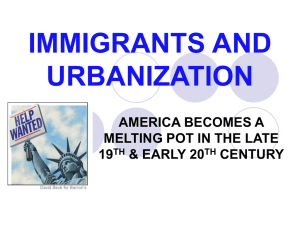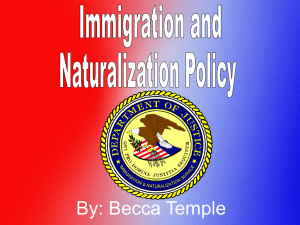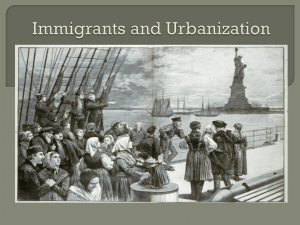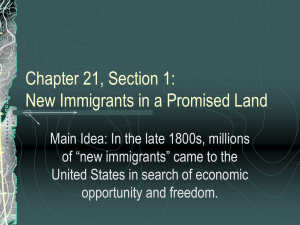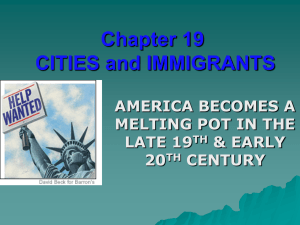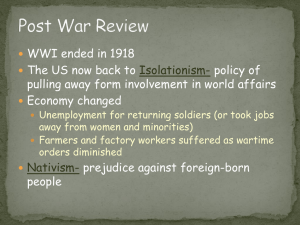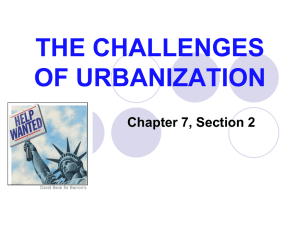Chapter 7 Powerpoint
advertisement
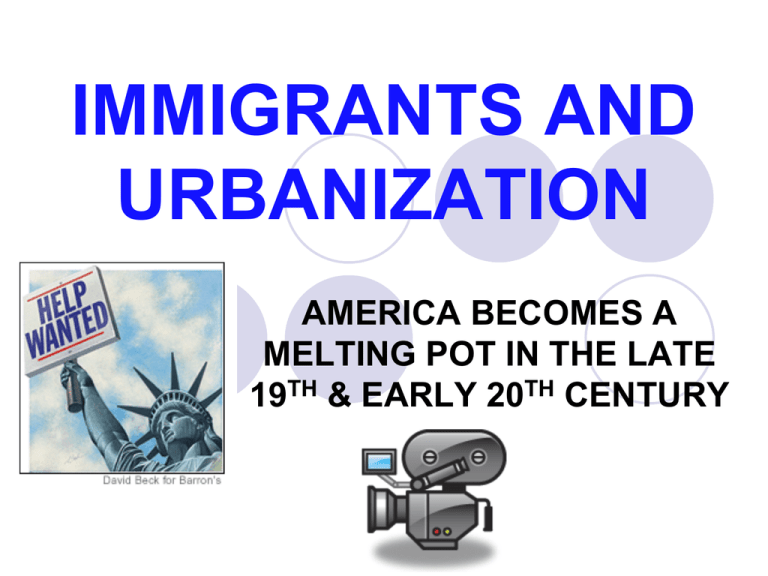
IMMIGRANTS AND URBANIZATION AMERICA BECOMES A MELTING POT IN THE LATE 19TH & EARLY 20TH CENTURY U.S. Immigration 1830-2000 National Origins Acts (Quota Acts) “Open” Immigration Immigration & Nationality Act Gentlemen’s Agreement Chinese Exclusion Act Three Waves of U.S. Immigration First Wave (Old Immigrants) 1840-1860 Second Wave (New Immigrants) 1880-1920 Third Wave (Newest Immigrants) 1965Present First Wave (Old) Immigrants Arrived: 1840-1860 Origins: Ireland & Germany Most were Catholic Push Factors: Potato Famine, Religious & Political Persecution and Instability Pull Factors: Jobs in northeastern factories A Nativist Political Cartoon Discrimination Against Asians Chinese laborers recruited for railroad construction in the West CA excluded from mining Chinese Exclusion Act (1882): Prohibited Chinese & Korean Immigration to U.S. Gentlemen’s Agreement (1907): Japan would not allow its citizens to migrate to the U.S. By Thomas Nast (1882) Second Wave (New) Immigrants Arrived 1880-1920 Origins: Southern & Eastern Europe Diverse Languages & Religions (Catholic, Jewish, & Eastern Orthodox) Push Factors: Religious persecution, economic & politicl instability Pull Factors: Jobs created by industrialization Second Wave Immigration 18801920 Third Wave (Newest) Immigrants Arrived 1965-Present Origins: Everywhere... (Esp. Latin America, Asia, Eastern Europe) Push Factors: Lower standard of living, ethnic or religious persecution Pull Factors: Jobs & economic prosperity A Naturalization Ceremony for New Citizens SECTION 1:THE NEW IMMIGRANTS Millions of immigrants entered the U.S. in the late 19th and early 20th centuries Some came to escape difficult conditions, others known as “birds of passage” intended to stay only temporarily to earn money, and then return to their homeland EUROPEANS Between 1870 and 1920, about 20 million Europeans arrived in the United States Before 1890, most were from western and northern Europe After 1890, most came from southern and eastern Europe All were looking for opportunity CHINESE Between 1851 and 1882, about 300,000 Chinese arrived on the West Coast Some were attracted by the Gold Rush, others went to work for the railroads, farmed or worked as domestic servants An anti-Chinese immigration act by Congress curtailed immigration after 1882 Many Chinese men worked for the railroads JAPANESE In 1884, the Japanese government allowed Hawaiian planters to recruit Japanese workers The U.S. annexation of Hawaii in 1898 increased Japanese immigration to the west coast By 1920, more than 200,000 Japanese lived on the west coast THE WEST INDIES AND MEXICO Between 1880 and 1920, about 260,000 immigrants arrived in the eastern and southeastern United States from the West Indies They came from Jamaica, Cuba, Puerto Rico, and other islands Mexicans, too, immigrated to the U.S. to find work and flee political turmoil – 700,000 Mexicans arrived in the early 20th century LIFE IN THE NEW LAND In the late 19th century most immigrants arrived via boats The trip from Europe took about one week, while it took about 3 weeks from Asia The trip was arduous and many died along the way Destination was Ellis Island for Europeans, and Angel Island for Asians ELLIS ISLAND, NEW YORK Ellis Island was the arrival point for European immigrants They had to pass inspection at the immigration stations Processing took hours, and the sick were sent home Immigrants also had to show that they were not criminals, had some money ($25), and were able to work From 1892-1924, 17 million immigrants passed through Ellis Island’s facilities ELLIS ISLAND, NEW YORK HARBOR ANGEL ISLAND, SAN FRANCISCO Asians, primarily Chinese, arriving on the West Coast gained admission at Angel Island in the San Francisco Bay Processing was much harsher than Ellis Island as immigrants withstood tough questioning and long detentions in filthy conditions ANGEL ISLAND WAS CONSIDERED MORE HARSH THAN ELLIS ISLAND Immigration: The Old vs The New FRICTION DEVELOPS While some immigrants tried to assimilate into American culture, others kept to themselves and created ethnic communities Committed to their own culture, but also trying hard to become Americans, many came to think of themselves as ItalianAmericans, Polish-Americans, Chinese-Americans, etc Some native born Americans disliked the immigrants unfamiliar customs and languages – friction soon developed Chinatowns are found in many major cities IMMIGRANT RESTRICTIONS Anti-Asian feelings included restaurant boycotts As immigration increased, so did anti-immigrant feelings among natives Nativism (favoritism toward native-born Americans) led to antiimmigrant organizations and governmental restrictions against immigration In 1882, Congress passed the Chinese Exclusion Act which limited Chinese immigration until 1943 Caption Title Caricature Labels Symbolism Exaggeration Satire Irony The shadows of immigrant origins loom over restrictionist American plutocrats. Hypocrisy over immigration Big Picture Question How can we use what we've learned about past immigration to understand immigration today? SECTION 2: THE CHALLENGES OF URBANIZATION Rapid urbanization occurred in the late 19th century in the Northeast & Midwest Most immigrants settled in cities because of the available jobs & affordable housing By 1910, immigrants made up more than half the population of 18 major American cities MIGRATION FROM COUNTRY TO CITY Discrimination and segregation were often the reality for African Americans who migrated North Rapid improvements in farm technology (tractors, reapers, steel plows) made farming more efficient in the late 19th century It also meant less labor was needed to do the job Many rural people left for cities to find workincluding almost ¼ million African Americans URBAN PROBLEMS Problems in American cities in the late 19th and early 20th century included: Housing: overcrowded tenements were unsanitary Sanitation: garbage was often not collected, polluted air Famous photographer Jacob Riis captured the struggle of living in crowded tenements URBAN PROBLEMS CONTINUED Transportation: Cities struggled to provide adequate transit systems Water: Without safe drinking water cholera and typhoid fever was common Crime: As populations increased thieves flourished Fire: Limited water supply and wooden structures combined with the use of candles led to many major urban fires – Chicago 1871 and San Francisco 1906 were two major fires Harper’s Weekly image of Chicagoans fleeing the fire over the Randolph Street bridge in 1871 PHOTOGRAPHER JACOB RIIS CAPTURED IMAGES OF THE CITY Jacob Riis Jacob Riis Jacob Riis Jacob Riis Jacob Riis Directions: Analyze this Photograph on a sheet of your own paper Jacob Riis REFORMERS MOBILIZE Jacob Riis was a reformer who through his pictures hoped for change– he influenced many The Social Gospel Movement preached salvation through service to the poor Some reformers established Settlement Homes These homes provided a place to stay, classes, health care and other social services Jane Addams was the most famous member of the Settlement Movement (founded Hull House in Chicago) Jane Addams and Hull House SECTION 3: POLITICS IN THE GILDED AGE As cities grew in the late 19th century, so did political machines Political machines controlled the activities of a political party in a city Ward bosses, precinct captains, and the city boss worked to ensure their candidate was elected William M. Tweed “Boss Tweed” ROLE OF THE POLITICAL BOSS The “Boss” (typically the mayor) controlled jobs, business licenses, and influenced the court system Precinct captains and ward bosses were often 1st or 2nd generation immigrants so they helped immigrants with naturalization, jobs, and housing in exchange for votes Boss Tweed ran NYC MUNICIPAL GRAFT AND SCANDAL Some political bosses were corrupt Some political machines used fake names and voted multiple times to ensure victory (“Vote early and often”) – called Election fraud Graft (bribes) was common among political bosses Construction contracts often resulted in “kickbacks” The fact that police forces were hired by the boss prevented close scrutiny THE TWEED RING SCANDAL William M. Tweed, known as Boss Tweed, became head of Tammany Hall, NYC’s powerful Democratic political machines Between 1869-1871, Tweed led the Tweed Ring, a group of corrupt politicians, in defrauding the city Tweed was indicted on 120 counts of fraud and extortion Tweed was sentenced to 12 years in jail – released after one, arrested again, and escaped to Spain Boss Tweed CIVIL SERVICE REPLACES PATRONAGE Applicants for federal jobs are required to take a Civil Service Exam Nationally, some politicians pushed for reform in the hiring system The system had been based on Patronage; giving jobs and favors to those who helped a candidate get elected Reformers pushed for an adoption of a merit system of hiring the most qualified for jobs The Pendleton Civil Service Act of 1883 authorized a bipartisan commission to make appointments for federal jobs based on performance Directions: Analyze this Political Cartoon on a sheet of your own paper Directions: Analyze this Political Cartoon on a sheet of your own paper Tweed-le-dee and Tilden-dum A Harper's Weekly cartoon depicts Tweed as a police officer saying to two boys, "If all the people want is to have somebody arrested, I'll have you plunderers convicted. You will be allowed to escape, nobody will be hurt, and then Tilden will go to the White House and I to Albany as Governor."

